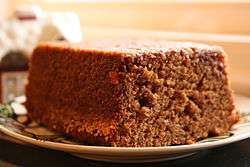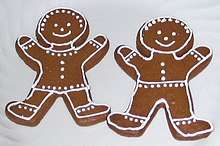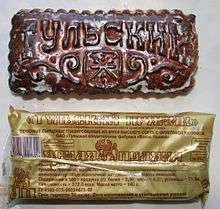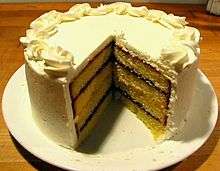Gingerbread
Gingerbread refers to a broad category of baked goods, typically flavored with ginger, cloves, nutmeg or cinnamon and sweetened with honey, sugar or molasses. Gingerbread foods vary, ranging from a soft, moist loaf cake to something close to a ginger snap.[1]
 | |
| Main ingredients | Ginger root, honey or molasses |
|---|---|
Etymology
Originally, the term gingerbread (from Latin zingiber via Old French gingebras) referred to preserved ginger. It then referred to a confection made with honey and spices. Gingerbread is often used to translate the French term pain d'épices (literally "spice bread") or the German terms Pfefferkuchen (lit. "pepper cake", back then, when all spices were called "pepper") or Lebkuchen (of unclear etymology. Either Latin libum, meaning "sacrifice" or "sacrificial bread". Or German "Laib" for loaf).
History

Gingerbread is claimed to have been brought to Europe in 992 CE by the Armenian monk Gregory of Nicopolis (also called Gregory Makar and Grégoire de Nicopolis).[2] He left Nicopolis (in modern-day western Greece) to live in Bondaroy (north-central France), near the town of Pithiviers. He stayed there for seven years and taught gingerbread baking to French Christians. He died in 999.
In the 13th century in the Polish city of Torun gingerbread or Torun gingerbread began to be produced and quickly gained fame in the country and abroad, it was then brought to Sweden by German immigrants. In 15th-century Germany, a gingerbread guild controlled production.[3] Early references from the Vadstena Abbey show that the Swedish nuns baked gingerbread to ease indigestion in 1444.[4] It was the custom to bake white biscuits and paint them as window decorations.
The first documented trade of gingerbread biscuits in England dates to the 17th century, where they were sold in monasteries, pharmacies, and town square farmers' markets. In England gingerbread was thought to have medicinal properties.[5] One hundred years later, the town of Market Drayton in Shropshire, England became known for its gingerbread, as is displayed on their town's welcome sign, stating that it is the "home of gingerbread". The first recorded mention of gingerbread being baked in the town dates to 1793, although it was probably made earlier, as ginger had been stocked in high street businesses since the 1640s. Gingerbread became widely available in the 18th century.
Gingerbread came to the Americas with settlers from Europe. Molasses, which was less expensive than sugar, soon became a common ingredient and produced a softer cake. The first American cookbook, American Cookery by Amelia Simmons published in 1796, contained seven different recipes for gingerbread.[6]
Varieties

In England, gingerbread may refer to a cake, or type of cookie or biscuit made with ginger. In the biscuit form, it commonly takes the form of a gingerbread man. Gingerbread men were first attributed to the court of Queen Elizabeth I, who served the figurines to foreign dignitaries.[7] Today, however, they are generally served around Christmas. Gingerbread was a traditional confectionery sold at popular fairs, often given as a treat or token of affection to children and lovers "sweethearts" and known as a "fairing" of gingerbread - the name retained now only by Cornish fairings. This crisp brittle type of gingerbread is now represented by the very popular commercial version called the ginger nut biscuit.
Parkin is a form of soft gingerbread cake made with oatmeal and treacle which is popular in northern England, originating in Yorkshire.
In the United States, this form of gingerbread is sometimes called "gingerbread cake" or "ginger cake" to distinguish it from the harder forms. French pain d'épices is somewhat similar, though generally slightly drier, and involves honey rather than treacle. Originally, French pain d'épices did not contain ginger.
In the Netherlands and Belgium, a soft and crumbly gingerbread called peperkoek, kruidkoek or ontbijtkoek is popularly served at breakfast time or during the day, thickly sliced and often topped with butter.
In Germany gingerbread is made in two forms: a soft form called Lebkuchen and a harder form, particularly associated with carnivals and street markets such as the Christmas markets that occur in many German towns. The hard gingerbread is made in decorative shapes, which are then further decorated with sweets and icing. The tradition of cutting gingerbread into shapes takes many other forms, and exists in many countries, a well-known example being the gingerbread man. Traditionally, these were dunked in port wine.
In Ashkenazi Jewish cuisine, the honey cake eaten at Rosh Hashanah (New Year) closely resembles the Dutch peperkoek or the German Lebkuchen, though it has wide regional variations.
In the Nordic countries, the most popular form of ginger confection is the pepperkaker (Norwegian), pepparkakor (Swedish), brunkager (Danish), piparkökur (Icelandic), piparkakut (Finnish) and piparkūkas (Latvian) or piparkoogid (Estonian). They are thin, brittle biscuits that are particularly associated with the extended Christmas period. In Norway and Sweden, pepperkaker/pepparkakor are also used as window decorations (the pepperkaker/pepparkakor are a little thicker than usual and are decorated with glaze and candy). Many families bake pepperkaker/pepparkakor/brunkager as a tradition.
In Switzerland, a gingerbread confection known as "biber" is typically a two-centimeter (approximately ¾ of an inch) thick rectangular gingerbread cake with a marzipan filling. The cantons of Appenzell and St. Gallen are famous for biber, which are artfully adorned with images of the Appenzell bear or the St. Gallen cathedral respectively by engraving or icing.
In Russia, a gingerbread maker was first mentioned in Kazan cadastres in 1568.[8] Gingerbread confections are called pryaniki (sg. pryanik), derived from the Russian term for 'spices'. Historically three main centers of gingerbread production have developed in the cities of Vyazma, Gorodets, and Tula. Gingerbreads from Tver, Saint Petersburg and Moscow were also well known in the Russian Empire. A classic Russian gingerbread is made with rye flour, honey, sugar, butter, eggs and various spices; it has an embossed ornament and/or text on the front side with royal icing.[9] A Russian gingerbread can also be shaped in various forms and stuffed with varenje and other sweet fillings.
In Poland, gingerbreads are known as pierniki (singular: piernik). Some cities have traditional regional styles. Toruń gingerbread (piernik toruński) is a traditional Polish gingerbread that has been produced since the Middle Ages in the city of Toruń. It was a favorite delicacy of Chopin when he visited his godfather, Fryderyk Florian Skarbek, in Toruń during a school vacation. Kraków gingerbread is the traditional style from the former Polish capital.
In Czech Republic pardubický perník is known.[10]
In Romania, gingerbread is called turtă dulce and usually has sugar glazing.
A variety of gingerbread in Bulgaria is known as меденка ("made of honey"). Traditionally the cookie is as big as the palm of a hand, round and flat, and with a thin layer of chocolate. Other common ingredients include honey, cinnamon, ginger and dried clove.
Gingerbread is popular in England, and is available in supermarkets. As in other countries, gingerbread biscuits are often decorated with royal icing.
In Panama, a confection named yiyinbre is a gingerbread cake made with ginger and molasses; it is typical of the region of Chiriquí. Another popular confection is quequi or queque, a chewy biscuit made with ginger, molasses and coconut.
See also
- Dutch carnival cake
- Ginger snaps
- Gingerbread house
- Gingerbread man
- Gingerbread Museum
- Lebkuchen
- Licitar
- List of sweet breads
- Ontbijtkoek
- Pain d'épices
References
- The Oxford Companion to Sugar and Sweets. Oxford University Press. 1 April 2015. ISBN 978-0-19-931362-4.
- Liana Aghajanian (2014-12-23). "How an Armenian Monk Brought Gingerbread to the West". Retrieved 2017-03-30.
- Anderson, L. V. "Why Do We Shape Gingerbread Cookies Like People?". Browbeat (blog). Slate. Retrieved 24 December 2013.
- "Archived copy". Archived from the original on 2010-03-10. Retrieved 2009-11-11.CS1 maint: archived copy as title (link)
- "What is the history of gingerbread?". eNotes.
- Byrn, Anne (2016). American cake : from colonial gingerbread to classic layer, the stories and recipes behind more than 125 of our best-loved cakes. pp. 12–16. ISBN 9781623365431. OCLC 934884678.
- Donald F. Lach (2010). "Asia in the Making of Europe, Volume II: A Century of Wonder. Book 3: The Scholarly Disciplines, Volume 2". p. 442. University of Chicago Press
- Slovar' russkogo jazyka XI-XVII vv. 21. Moscow: Nauka. 1995. p. 31.
- "Chef doma: Pryaniki i sbiten' Maksima Syrnikova". The Village. 14 December 2012. Retrieved 11 December 2015.
- http://pardubickypernik.cz/
External links
| Look up gingerbread in Wiktionary, the free dictionary. |
- Gingerbread at the Open Directory Project
- Dundee gingerbread through the ages
- The world's largest gingerbread town

